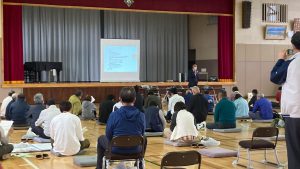Let’s discuss to move on! DRR should be long-term, community-based. Integrated and mainstreamed [Nagano/Japan]
On 24th April, the eighth Naganuma District whole-town meeting was held at the gymnasium of Naganuma Elementary School, Nagano, Japan. Two and a half years have passed since the levee along the Chikuma river breached, and this was the eighth gathering to discuss the future of the district. Approximately 110 people attended, including about 80 district residents.

About a year ago, at the seventh meeting, various topics were discussed including how to rebuild the levee, whether to replant cherry trees along the levee, what kind of a river disaster management center could be developed, and how to recover the community. It was reported in this day’s meeting that there have been various discussions and consensus-building since last year.

During the meeting, Chair of the Naganuma District Community Council spoke about the strengthened partnership between the Council and one of its committees specializing in disaster recovery: the Disaster Recovery Planning Committee. He also emphasized that the Council’s operation was back to normal from that of disaster emergency, and that the whole-town meetings were a very important platform to exchange opinions of everybody. This was followed by updates on their new organizational structure, on review and report of the previous fiscal year, and on reconstruction of infrastructure.
1. New organizational structure of the Naganuma District Community Council
A “Community Building Committee” has been established under the Council. The Community Recovery Planning Committee also renewed its members for the new fiscal year. The Nagano city government also introduced its cross-sectional team called “ONE HEART” to support disaster recovery of the district by reviewing and updating its existing community development plan.

2. Review and report of the previous fiscal year (April 2021 – March 2022)
Firstly, the focus group on the river disaster management center reported about their agreed-on and finalized floor plans with an emphasis on gathering and relaxation. It was also explained that further discussion is required for a management protocol and rules of use by residents. The group will continue to explore residents-focused management of the facilities and outdoor areas.
Secondly, the focus group on the areas surrounding the Naganuma Elementary School and other education facilities shared their outputs of a series of discussions regarding the opening of the Naganuma Children’s Center on 6th April, and the newly agreed-on location of the Naganuma Nursery School next to the elementary school. Use of the area where the school pool was located, and expansion of roads surrounding the school was also discussed. It is hoped that collaborative activities between the school and the nursery will be enhanced and that their facilities will be used in disaster emergencies.
Thirdly, the group on building a public housing complex in the district reported on their negotiations with government agencies. The update of not being able to realize concrete results was shared, along with their intention to keep on communicating with community members who have concerns about their residences, and that opinions will be listened to and proposed to the city.
Lastly, the Community Recovery Subcommittee shared their output of the “Apples for Disaster Recovery and Community Development” which compiled the district residents’ opinions collected through apple-shaped cards. Other outputs including the “Ringo-shan (combining ringo, “apple” in Japanese, and “go-shan”, a dialect in Nagano meaning “expert/teacher”) and “Naganumap” that illustrates the district with various information including charms, hopes and challenges faced by its residents on a map. “Ringo-shan” and “Naganumap” are both based on the voices from the community members, and are outputs of a joint effort between the Subcommittee and SEEDS Asia.

3. Reconstruction of infrastructure
The Nagano Prefectural Construction Office explained progress on desgnating river dikes along the Chikuma river as a symbol of disaster recovery and making it a prefectural road. Chikuma River Management Office shared their plan for long-term reconstruction of the Chikuma river. Other initiatives such as community timeline for disaster preparedness, and promotion of river-related activities for younger generation as a joint effort of enhanced facilities and events were also discussed.
Questions and comments by participants followed, such as “There are buried cultural properties from the now lost Naganuma castle and they are currently being excavated before the development of the river disaster management center. What kind of items have been found? In case historically significant items have been found, will that affect the plan of the center?”, “There are quite a number of organizations established: District Community, Council, Disaster Recovery Planning Committee, Community Building Committee, ONE HEART, and Community Recovery Subcommittee. Could you define and explain to us specific roles and functions among those?”, “How will you respond to not being able to build a public house for residents who have lost their homes in the district?”, “Would it be possible to have the prefectural road on the river dikes extended further south?”, and “Please maintain widths of roads leading up to the prefectural road.”

The meeting served as a venue for the community members and government bodies to actively share outputs and challenges faced. The Community Recovery Planning Committee’s membership will expire in one year who have been committed to initiating disaster recovery efforts. It is essential that the Committee will actively partner with the newly established Community Building Committee, and that an organic network is built towards consensus-building among residents, different organizations, and different peoples, in order to pass the values that Naganuma possesses on to the future. SEEDS Asia is hoping to be of help towards Naganuma’s disaster recovery, with the help of various stakeholders.
